Are you ready to discover the joy of gardening and transform your backyard into a blissful haven? Look no further than this guide that will provide you with all the tips and advice you need to create a beautiful and thriving garden. Whether you’re a seasoned gardener or a beginner, this book will offer valuable insights into creating a low-maintenance perennial garden that brings joy and satisfaction for years to come.
Key Takeaways
- Creating a low-maintenance perennial garden can bring joy and satisfaction for years to come.
- Choosing the right plants and implementing effective care practices is essential for creating a self-sustaining ecosystem.
- Maintaining healthy soil, conserving water, and designing a garden that attracts beneficial species can minimize the need for chemical pest control.
- Gardening can improve physical and mental health.
Embracing the Beauty of Backyard Gardening
Backyard gardening offers a unique and rewarding experience, allowing you to design and create your own personal haven. In today’s fast-paced world, it’s easy to become overwhelmed by responsibilities and stress. However, by embracing the beauty of backyard gardening, individuals can find harmony and balance in their lives. With the help of low-maintenance perennial gardens, creating a thriving outdoor space that brings joy without overwhelming responsibilities is possible.
When selecting plants for your garden, consider implementing perennials that require little maintenance. These plants will come back year after year and are often more resistant to pests and diseases, providing a beautiful and low-maintenance garden. Care practices such as regular watering and pruning can also ensure the long-term health of your plants.
Creating a self-sustaining ecosystem is another way to ensure the longevity of your garden. By attracting beneficial insects and wildlife, you can reduce the need for pesticides and herbicides. This not only supports the environment but also creates a beautiful and natural ecosystem in your own backyard.
Embracing automation and simplicity in garden design can also bring more happiness and fulfillment to your gardening journey. For instance, container gardening can be both low-maintenance and visually stunning, allowing you to create a beautiful garden without requiring large amounts of time and effort.
The book “Perennial Bliss: Keeping a Beautiful Garden with Little Work” provides valuable advice on maintaining healthy soil, conserving water, attracting beneficial wildlife, and designing a garden that remains appealing throughout the year. This book is written by the author, Perla Sofía Curbelo-Santiago, a passionate advocate for using gardening to enhance physical and mental health.
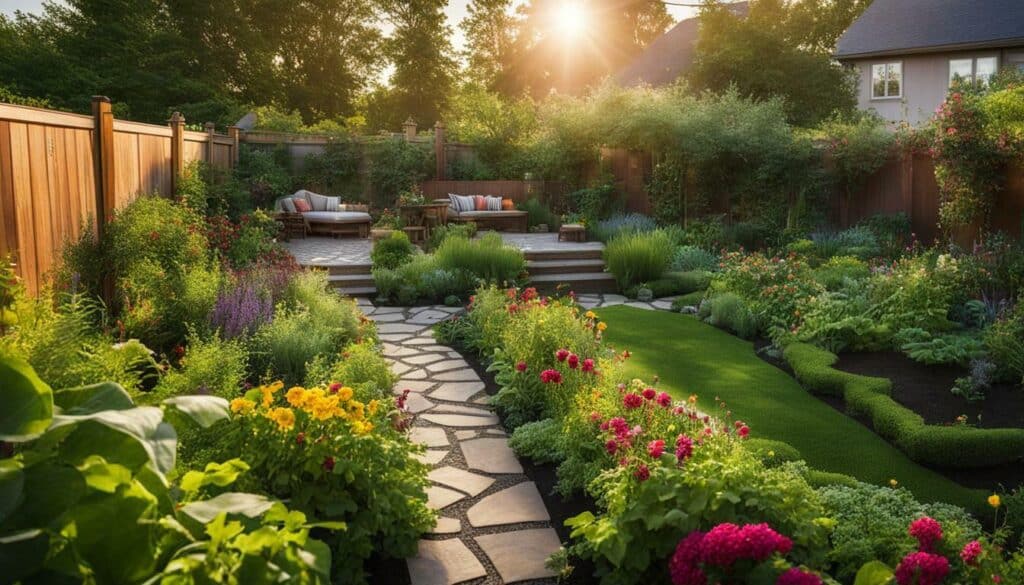
By embracing the beauty of backyard gardening, individuals can create a calming environment that captures the beauty of nature and provides a sense of peace and happiness amid the busyness of life. With careful planning and maintenance, anyone can have a garden that brims with color and vitality while needing little maintenance. So, why not start your backyard gardening journey today and see the joy and fulfillment it can bring to your life?
Selecting the Right Plants for Your Garden
Choosing the right plants is crucial to creating a thriving perennial garden that will bring beauty and joy year after year. When selecting plants, it is important to consider factors such as your garden’s microclimate, soil type, and sun exposure. By carefully choosing plants that are well-suited to your garden’s environment, you can create a low-maintenance garden that is both visually appealing and easy to care for.
Perennial plants are a great choice for those looking to create a beautiful garden with minimal effort. These hardy plants can survive through the winter and come back year after year, making them a great investment for any garden. When selecting perennial plants, look for those that require minimal maintenance and can thrive in a variety of conditions. Some great options include coneflowers, black-eyed susans, and daylilies.
| Plant | Sun Exposure | Soil Type | Height |
|---|---|---|---|
| Coneflower | Full Sun to Partial Shade | Well-Draining Soil | 2-4 Feet |
| Black-Eyed Susan | Full Sun | Well-Draining Soil | 2-3 Feet |
| Daylily | Full Sun to Partial Shade | Well-Draining Soil | 1-4 Feet |
In addition to selecting the right plants, it is important to maintain healthy soil in your garden. Adding compost and other organic matter to your soil can help improve its structure and fertility, allowing your plants to thrive. Watering your plants deeply and infrequently can also help encourage deep root growth and reduce the need for frequent watering.
With the right plants and proper care, any gardener can create a stunning flower garden that will bring beauty and joy year after year. Whether you’re a seasoned gardener or just starting out, the book “Perennial Bliss: Keeping a Beautiful Garden with Little Work” by Perla Sofía Curbelo-Santiago offers valuable advice on selecting resilient, long-lasting perennials, maintaining healthy soil, conserving water, attracting beneficial species, and handling seasonal changes. As a gardening expert with a background in psychology and horticultural therapy, Curbelo-Santiago’s book is a must-read for anyone looking to create a sustainable and effortlessly beautiful garden.
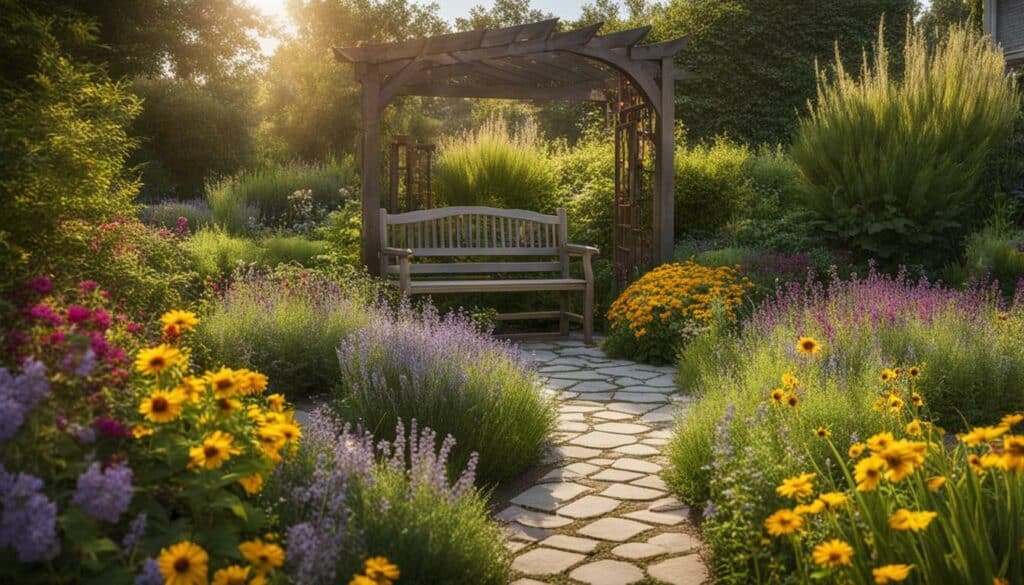
Maintaining Healthy Soil for a Lush Garden
Good garden maintenance starts with healthy soil – the foundation for a lush and thriving garden. In order to create an ecosystem that sustains itself, it is important to choose the right perennial plants and to practice effective care techniques. In the book, “Perennial Bliss: Keeping a Beautiful Garden with Little Work,” readers can find valuable advice on maintaining healthy soil and fertilizing plants. Tips for pruning and deadheading are also provided.
One key strategy for maintaining healthy soil is to practice organic gardening. This means avoiding the use of synthetic fertilizers and pesticides, which can harm beneficial species and insects, as well as pollute the environment. Instead, gardeners can use compost and other natural fertilizers, such as bone meal or fish emulsion, to supply essential nutrients to their plants.
Another effective technique for maintaining healthy soil is to use a mulch layer to retain moisture and prevent weeds. Mulch materials can be organic, such as shredded leaves or straw, or inorganic, such as pebbles or gravel. In addition to mulch, adding organic matter to the soil, such as compost or aged manure, can improve soil structure and fertility.
| Tip | Benefit |
|---|---|
| Water deeply and infrequently | Encourages root growth and reduces water waste |
| Rotate crops | Prevents soil-borne diseases and pests |
| Test the soil | Allows for targeted fertilization and pH adjustments |
In addition to maintaining healthy soil, gardeners can also design their gardens to conserve water and attract beneficial species and insects. By using a combination of rain barrels, drip irrigation, and other water-saving techniques, gardeners can create a sustainable vegetable garden that produces bountiful harvests with minimal water usage.
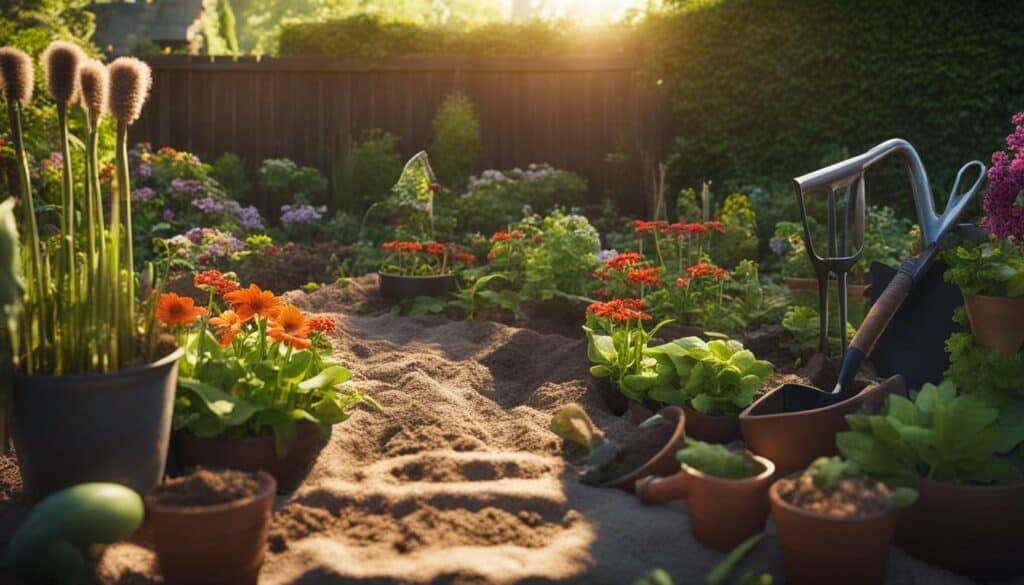
Finally, by embracing automation, simplicity, and nature, gardeners can create a calming environment that promotes mental well-being and physical health. As author, Perla Sofía Curbelo-Santiago emphasizes, “The most beautiful gardens are those that are allowed to grow and evolve naturally, without being overly controlled or manipulated.” By following the principles of organic gardening and self-sustainability, gardeners can create a garden that not only brings joy and happiness but also helps to protect the environment for future generations.
Water Conservation Tips for a Sustainable Garden
In today’s world, water conservation is more important than ever, and these tips will help you create a sustainable and thriving vegetable garden.
One effective way to conserve water in the garden is by using drip irrigation. This method delivers water directly to the plant’s roots, which reduces water waste and promotes healthy growth. Another option is to install a rain barrel, which collects rainwater for use in the garden. This reduces the need for municipal water and is a great way to use a natural resource that might otherwise go to waste.
When designing your vegetable garden, it is important to consider the layout and placement of plants. Grouping plants with similar watering needs together can help you avoid over-watering or under-watering. Additionally, choosing drought-resistant plant varieties can help you conserve water while still enjoying a bountiful harvest.
Using mulch is another effective way to conserve water in the garden. Mulch helps to prevent water evaporation, suppress weed growth and keep soil moisture levels consistent. Adding a layer of organic mulch around your plantings can go a long way in reducing water use and maintaining a healthy garden.
Finally, taking steps to attract beneficial species and insects to your garden can help you meet conservation goals. For example, planting native flowers and shrubs can attract pollinators and beneficial insects that help control pests. This can reduce the need for pesticides and prevent harm to the environment.
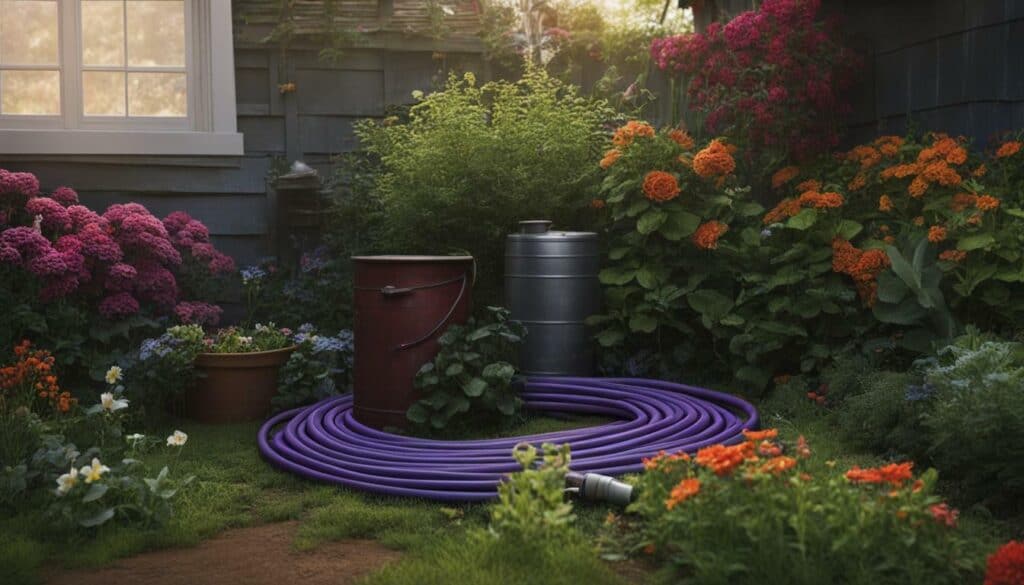
Implementing these water conservation tips can help you create a beautiful and eco-friendly vegetable garden, while also doing your part to conserve this precious resource.
Inviting Beneficial Species and Insects into Your Garden
Creating a garden that welcomes beneficial species and insects is not only good for the environment, but it also helps maintain a balanced and healthy ecosystem. By encouraging these species, you can help control pests and reduce the need for chemical pesticides. One way to do this is by selecting the right perennial plants for your garden.
| Plant Type | Beneficial Species |
|---|---|
| Lavender | Bees, butterflies, moths |
| Echinacea | Butterflies, birds, bees |
| Milkweed | Butterflies, bees |
These plants attract a variety of beneficial species to your garden.
Another way to invite beneficial species and insects into your garden is by creating a self-sustaining ecosystem. This can be achieved by maintaining healthy soil, planting a diverse range of plants, and avoiding the use of chemical fertilizers and pesticides. For example, by planting a diverse range of plants, you can provide an array of habitats and food sources for pollinators and other beneficial species.
Conserving water is also essential in creating a sustainable garden. Installing a rain barrel to collect rainwater can help reduce water usage and provide a natural source of water for plants and insects.
Designing your garden to encourage beneficial species is key. Consider planting a variety of flowers, shrubs, and trees to provide a diverse range of habitats and food sources. You can also create a habitat for beneficial species by incorporating features such as birdhouses, butterfly houses, and bee hotels.
Embracing automation and simplicity can also lead to a more enjoyable gardening experience. Container gardening is a simple and low-maintenance way to create a beautiful garden while minimizing the need for water and soil maintenance. Adding a few pots of herbs or flowers to your patio or balcony can also attract beneficial species to your outdoor space.
By attracting beneficial insects and species, you can create a balanced and vibrant garden that is not only good for the environment but also for your well-being. Take the time to research the plants and practices that best suit your garden’s needs, and enjoy the beauty and benefits of a sustainable garden.
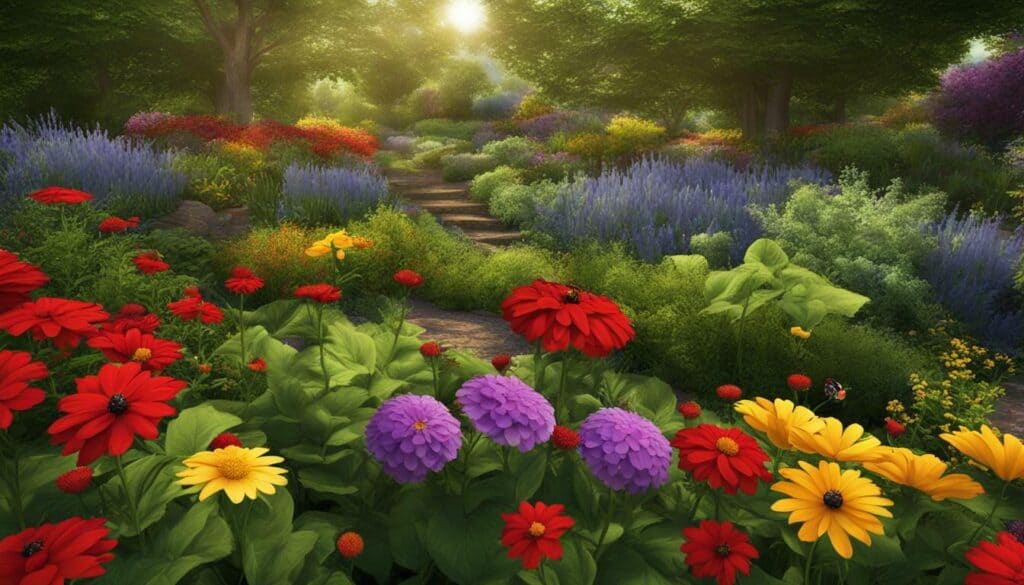
Embracing Automation and Simplicity in Gardening
Embracing automation and simplicity can transform your gardening experience, and container gardening is a perfect way to achieve this goal. With a little planning and the right tools, you can create a low-maintenance garden that thrives with minimal effort.
The book “Perennial Bliss: Keeping a Beautiful Garden with Little Work” offers practical advice on designing a self-sustaining ecosystem and selecting the right perennial plants for your garden. By focusing on plants that are well-suited to your climate and soil, you can reduce the need for watering, fertilizing, and other maintenance tasks.
One of the biggest advantages of container gardening is that it makes automation and simplicity easy to achieve. With a simple irrigation system and the right soil mix, your plants can thrive with minimal input from you. Container gardening also allows you to move your plants around as needed, whether you’re chasing the sun or creating a new garden layout.
Maintaining your soil is crucial to the success of any garden, and container gardening is no exception. Use high-quality organic soil and compost to provide your plants with essential nutrients and improve soil structure. With healthy soil, your plants will be better equipped to resist pests and diseases, reducing the need for chemical interventions.
Conserving water is another key consideration for any garden, and container gardening offers several advantages in this regard. You can easily set up a drip irrigation system or self-watering containers to reduce water usage and minimize the need for manual watering. Additionally, you can group plants with similar water needs together, optimizing the effectiveness of your watering efforts.
Attracting beneficial species and insects to your garden is an important element of automation and simplicity, as these helpers can perform many of the essential tasks required for a healthy garden. Bees, butterflies, and other pollinators are critical to the success of fruit and vegetable gardens, while ladybugs and other beneficial insects can help control pests naturally.
By embracing automation and simplicity in your gardening practices, you can create a beautiful and rewarding garden with minimal effort. Container gardening is an excellent way to start, and the book “Perennial Bliss” provides guidance on this and other low-maintenance gardening techniques. By taking a slower and more introspective approach to gardening, you can experience more happiness and fulfillment while tending to your plants.

The Mental Health Benefits of Gardening
Gardening is not just about physical health; it also has significant mental health benefits that can enhance your overall well-being. In today’s fast-paced world, where stress and anxiety are prevalent, gardening provides a perfect opportunity to relax and unwind. According to mental health experts, gardening can be a therapeutic activity that promotes mental well-being.
One of the primary mental health benefits of gardening is its ability to reduce stress. Spending time in nature and engaging in gardening activities can lower cortisol levels and promote relaxation. The physical act of gardening, such as planting, weeding, or watering plants, can serve as a form of mindfulness, helping individuals focus their attention on the present moment and alleviate anxiety and racing thoughts.
Gardening also provides a sense of accomplishment and fulfillment. Watching plants grow and thrive under one’s care can boost self-esteem and provide a sense of purpose. Additionally, gardening allows individuals to connect with nature and form a deeper appreciation for the natural world, further enhancing feelings of well-being.
Moreover, the act of gardening encourages physical activity, which has well-documented benefits for mental health. Regular exercise, even in the form of light gardening tasks, releases endorphins, the body’s natural mood-boosting chemicals. This can lead to improved mood, reduced symptoms of depression, and increased overall happiness.
Another significant mental health benefit of gardening is the opportunity for social interaction and community engagement. Gardening can be a shared activity, allowing individuals to connect with friends, family, or neighbors who share similar interests. Joining a community garden or participating in gardening clubs can provide a sense of belonging and social support, which are essential for mental well-being.

About the Author
I, Perla Sofía Curbelo-Santiago, am a psychology student and horticultural therapist who advocates using gardening as a healing tool. I have worked with individuals of all ages and backgrounds, utilizing gardening to address various mental health concerns. Through my experiences, I have witnessed firsthand the transformative power of gardening, and I am passionate about sharing its benefits with others.
Meet the Author: Perla Sofía Curbelo-Santiago
Let me introduce myself – I’m Perla Sofía Curbelo-Santiago, a passionate gardener and advocate for using gardening to enhance physical and mental health. I founded Agrochic.com, a gardening lifestyle platform in Spanish, to share my love and knowledge of gardening with others.
I have a bachelor’s degree in psychology from the University of Puerto Rico and a master’s degree in public relations from Universidad del Sagrado Corazón. I am a certified Horticultural Therapist from the Chicago Botanic Garden, which has deepened my understanding of the therapeutic benefits of gardening.
My work has been recognized by the American Horticultural Society, and I have contributed to various publications, including Better Homes and Gardens, HGTV Gardens, and Rodale’s Organic Life. I am also a gardening television contributor and have been featured on Telemundo, CNN en Español, and Univision.
I am affiliated with several organizations, including Garden Communicators International and the American Horticultural Therapy Association. I am also fluent in Spanish, English, and Italian, and continue to learn other languages.
Connect with me on Agrochic.com and social media platforms such as Facebook, Twitter, and Instagram to learn more about gardening and my mission to promote its physical and mental health benefits.

About Garden: Conclusion
Gardening is a fulfilling and enriching activity that brings joy and satisfaction – it’s time to immerse yourself in the world of gardens and discover your own blissful haven. Perennial Bliss: Keeping a Beautiful Garden with Little Work by Perla Sofía Curbelo-Santiago provides a comprehensive guide to creating a low-maintenance perennial garden that is both beautiful and stress-free. The book emphasizes the importance of finding harmony and balance in our lives, and how gardening can be a means to achieve this.
By selecting the right plants, maintaining healthy soil, conserving water, and inviting beneficial species and insects into your garden, you can create a vibrant and sustainable garden that requires minimal effort. The book also encourages a mental shift towards a slower, more introspective style of gardening, where automation and simplicity are embraced.
Whether you’re an experienced gardener or a beginner, Perennial Bliss offers valuable insights and practical advice that can help you create a garden that reflects your personal style and brings you happiness and peace. With its emphasis on low-maintenance, sustainable gardening practices, this book offers a path to perennial happiness in your own backyard.

Conclusion
Gardening is a fulfilling and enriching activity that brings joy and satisfaction – it’s time to immerse yourself in the world of gardens and discover your own blissful haven. Throughout this article, we have discussed the benefits of creating a low-maintenance perennial garden and how it can enhance our physical and mental health.
Perennial Bliss: Keeping a Beautiful Garden with Little Work, offers practical advice on selecting the right plants for your garden, maintaining healthy soil, conserving water, inviting beneficial species and insects, and utilizing smart tools. By embracing a slower and more introspective style of gardening, we can find balance and harmony in our lives.
As an author and passionate gardener, Perla Sofía Curbelo-Santiago is dedicated to using gardening to enhance our lives. Her work in the field has gained recognition, and she is affiliated with various gardening organizations.
Overall, the aim of creating a low-maintenance perennial garden is to create a calming environment that captures the beauty of nature and brings peace and happiness amidst our busy lives. So, why not start your own garden today and discover the joy about garden for yourself?
FAQ
Q: What is the main focus of the book “Discover the Joy About Garden: Your Guide to Blissful Gardening”?
A: The book aims to help readers create a low-maintenance perennial garden that brings joy and satisfaction.
Q: Why is finding harmony and balance important in gardening?
A: Finding harmony and balance in our lives, including in our gardens, is especially important in today’s fast-paced world.
Q: What advice does the book provide for selecting the right perennial plants?
A: The book provides tips on selecting the right perennial plants and creating a stunning flower garden.
Q: How can I maintain healthy soil for a lush garden?
A: The book emphasizes the importance of maintaining healthy soil and practicing organic gardening methods.
Q: What are some water conservation tips for a sustainable garden?
A: The book provides practical tips for conserving water and creating a sustainable vegetable garden.
Q: Why is it important to invite beneficial species and insects into your garden?
A: The book discusses the importance of attracting beneficial species and insects to create a balanced ecosystem in your garden.
Q: How can I embrace automation and simplicity in gardening?
A: The book explores the benefits of embracing automation and simplicity in garden design, with a focus on container gardening.
Q: What are the mental health benefits of gardening?
A: The book discusses the positive impact gardening can have on mental health and introduces the concept of horticultural therapy.
Q: Who is the author of the book and what is her background?
A: The author, Perla Sofía Curbelo-Santiago, is a gardener and passionate advocate for using gardening to enhance physical and mental health. She has a background in psychology and horticultural therapy.
What Does the Green Thumb Guide in “Unlock the Joy of Gardening” Offer?
The Unlock the Joy of Gardening green thumb guide is an essential resource for joyful gardening beginners. Offering valuable insights and practical tips, this guide helps novices navigate the world of gardening with confidence. It covers various topics such as selecting the right plants, maintaining a healthy garden, and effectively dealing with common challenges. With the joyful gardening beginners guide, individuals can unlock the true joy of gardening and cultivate beautiful, thriving green spaces.
Source Links
- https://www.goodreads.com/book/show/195553452-perennial-bliss
- https://www.barnesandnoble.com/w/perennial-bliss-katherine-smith/1143862261
- https://www.amazon.com/¡Verdura-Living-Projects-Nurture-Passion/dp/0760381267
- https://www.amazon.com/Joy-Your-Garden-Seasonal-Gardening/dp/1599552906
- https://www.amazon.com/Garden-Bliss-Cultivating-Landscape-Self-Discovery/dp/0738733822
- https://www.babyboomers.com/article/growing-old-growing-gardens-how-to-embrace-nature-s-beauty-in-the-golden-years/6495fbe285915a000108125e
- https://www.tallahassee.com/story/life/home-garden/2023/09/08/embrace-the-beauty-and-biodiversity-of-less-structured-garden/70781818007/
- https://vocal.media/earth/embracing-the-beauty-of-gardening
- https://www.provenwinners.com/learn/right-plant-right-place
- https://www.realhomes.com/advice/how-to-choose-plants-for-your-garden
- https://www.gardenersoasis.com/pick-the-right-plants/
- https://www.unsustainablemagazine.com/creating-a-beautiful-garden/
- https://www.almanac.com/soil-preparation-how-do-you-prepare-garden-soil-planting
- https://www.flowerpatchfarmhouse.com/how-to-build-organic-garden-soil/
- https://gatherandgrow.com/blog/14-ways-to-conserve-water-in-the-garden
- https://www.hgtv.com/outdoors/gardens/planting-and-maintenance/25-ways-to-conserve-water-in-your-garden-pictures
- https://www.finegardening.com/project-guides/gardening-basics/10-ways-to-conserve-water-in-the-garden
- https://www.almanac.com/beneficial-insects-garden
- https://caldwell.ces.ncsu.edu/2018/05/attract-your-allies-make-your-garden-inviting-to-beneficial-insects/
- https://thepestrangers.com/how-do-you-encourage-beneficial-insects-into-your-garden/
- https://www.linkedin.com/pulse/embracing-simplicity-capitalistic-ai-world-new-modern-jonathan-hobson
- https://www.chicagobotanic.org/blog/news/garden_embraces_artificial_intelligence
- https://www.southernliving.com/garden-trends-7097268
- https://agrilifetoday.tamu.edu/2022/04/25/the-positive-effects-of-gardening-on-mental-health/
- https://www.psychologytoday.com/us/blog/think-act-be/201906/10-mental-health-benefits-gardening
- https://www.ncbi.nlm.nih.gov/pmc/articles/PMC6334070/
- https://ahsgardening.org/about-us/news-press/meet-perla-sofia-curbelo/
- https://agrochic.com/about-agrochic-and-perla-sofia-curbelo/
- https://www.quarto.com/books/9780760381267/verdura-living-a-garden-life
- https://growingourown.wordpress.com/6-conclusion/
- https://chestofbooks.com/gardening-horticulture/Woman-Hardy-Garden/Chapter-XVI-Professional-Gardeners-Conclusion.html
- https://www.daleharvey.com/in-the-garden/articles-of-interest/PACIFIC STEEL SUTTON PARK/Sutton Park Primary School Gardening Project/Page 5 – Conclusion.html
- https://www.ncbi.nlm.nih.gov/books/NBK373975/





Leave a Reply